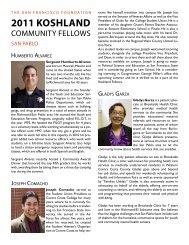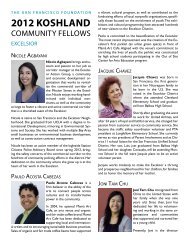2008 Koshland Connect - The San Francisco Foundation
2008 Koshland Connect - The San Francisco Foundation
2008 Koshland Connect - The San Francisco Foundation
Create successful ePaper yourself
Turn your PDF publications into a flip-book with our unique Google optimized e-Paper software.
2007<br />
West Berkeley<br />
alameda<br />
West Berkeley<br />
From Sacramento Avenue down to the shore of the Bay at the<br />
Berkeley Marina, West Berkeley has historically served as the<br />
strong, working shoulders of the City of Berkeley and surrounding<br />
region. It was here that immigrants from abroad, and African<br />
American migrants from the South, moved to work the bustling<br />
rail yards and war industries needed during World War II. <strong>The</strong>ir<br />
hard work propelled the local economy, and the industries they<br />
worked in created a new middle class of proud homeowners,<br />
though these industries began to decline in the 1960s.<br />
Today, West Berkeley still serves as one of the driving forces<br />
in the city. Approximately 1,500 businesses here employ more<br />
than 15,000 workers and generate more than 44% of the city’s<br />
sales tax revenues. Yet the economic health of residents in the<br />
community is nowhere near as prosperous as these numbers<br />
may indicate. According to the Northern California Council for<br />
the Community, West Berkeley is one of the Bay Area’s 52 most<br />
impoverished neighborhoods. <strong>The</strong> 2000 Census report revealed<br />
that 60% of households are low-income, 41.1% are very lowincome,<br />
and 31% of children live in poverty.<br />
<strong>The</strong> face of the community is also changing. Asian and Latino populations<br />
are on the rise. In the city of Berkeley, Asian Americans<br />
are the second largest ethnic group, and from 1990 to 2000 the<br />
Latino population doubled. As new immigrants move in, new<br />
challenges and issues arise, especially for African Americans who<br />
have been vital to the neighborhood’s prosperity and culture.<br />
Students at Berkeley Technology Academy.<br />
In 1990, African Americans accounted for 40.6% of West Berkeley<br />
residents. In a ten-year span the population fell to 29.1% according<br />
to the U.S. Census. By 2003, the median income of black<br />
households was less than half that of white and Asian households<br />
across Alameda County.<br />
“<strong>The</strong> economy is by far the most serious issue for everyone,<br />
especially those already living on a tight budget,” said Victor<br />
Diaz, principal of the Berkeley Technology Academy and <strong>Koshland</strong><br />
Fellow. “This obviously impacts our schools. Regardless of what<br />
people may think, parents from West Berkeley care deeply about<br />
their children’s education and want to be intimately involved.”<br />
Immigration information is exchanged at a BOCA-sponsored citizenship<br />
education event.<br />
6






